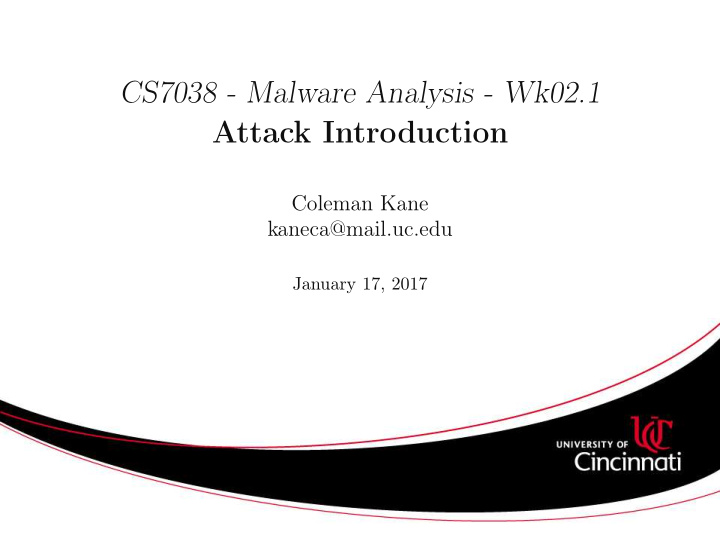



CS7038 - Malware Analysis - Wk02.1 Attack Introduction Coleman Kane kaneca@mail.uc.edu January 17, 2017 � �
Content This lecture covers the following concepts: Setting up lab environments in VirtualBox • Utilizing networking and shared folders features • Using kali to build a very rudimentary attack • Simulating delivery/targeting • Exploitation • Example of analysis of a malware sample • � �
Why Learn Attack? Understanding what an adversary wants to achieve, through intrusion, is important to inform your intuition and guide your conclusions about what you’re analyzing. Frequently, an attacker must take steps to self-analyze their own malware, in order to decide what modifications may need to be employed to side-step target-side mitigations. Part of doing malware analysis is going to include attempting to recreate attacker actions. Becoming familiar with attacks and attack tools will be vital in validating analysis conclusions, as well as determining if an attack can be prevented and/or detected based upon analysis findings. � �
Kali Linux You saw a brief experiment with Kali linux in the previous lecture. We will dive in further to this tool. Distributor : Offensive Security - https://www.kali.org OVA : Downloads->Download Kali Linux->KALI VIRTUAL IMAGES->VirtualBox Pre-built environment predominantly used for penetration testing and vulnerability assessments Tools included: Metasploit Framework - https://www.metasploit.com/ • Armitage - https://www.fastandeasyhacking.com/ • Powerfuzzer - https://www.powerfuzzer.com/ • OpenVAS - https://www.openvas.org/ • Burp Suite - https://portswigger.net/burp • � �
Basic Remote-Shell We will begin with a basic remote-shell attack. The objective is that we have identified a target and we would like to get some sort of interactive access to their system, so that we may gather more information about the target and possibly steal valuable information as well. One common approach is a simple “reverse shell”. Basically, get a payload onto the target’s computer such that the computer will initiate a connection back to a server you control, and will provide you command-line access to the system. Process: Set up your remote control listen server • Configure a payload to connect back to your listen server • Embed that payload in a carrier or trojan (in our case, a PDF) • Deliver the trojan to your target somehow • Social-engineer the target into opening the PDF with Acrobat reader • Wait for connection • � �
Key Concerns for Test Environment In the real world, the research for a successful attack can take weeks or even months. It is unrealistic, for us, to attempt to successfully attack an up-to-date system within the scope of this class. Rather, we will analyze attacks that are already known and mitigated against. To achieve this, we “cheat” and configure VM lab environments that are comprised of known-vulnerable components. In the real world, a number of mitigations are typically in place: Antivirus software • OS-level environment randomization • Newest versions of application software • Latest operating-system updates, closing known bugs • Many companies employ further network and endpoint analysis • mitigations as well With the right tooling and adequate time, attackers demonstrate that all fixes and mitigations are temporary . � �
Basic Attack Template Borrowed content and example from two sources: Building the payload and carrier. Simple reverse-shell using a PDF exploit against Acrobat 9.x and Windows XP or 7. http://null-byte.wonderhowto.com/how-to/ • hack-like-pro-embed-backdoor-connection-innocent-looking-pdf-0140942/ Configuring the listener for the reverse shell: https://www.offensive-security.com/metasploit-unleashed/ • binary-payloads/ An example might be to create the PDF in a manner that appears attractive to the recipient, and then send an unsolicited email to the recipient encouraging them to download and open the PDF using Acrobat reader. � �
Analyzing the Document Kali comes with a neat and useful malware analysis tool : PDFparser: https://blog.didierstevens.com/programs/ • pdf-tools/ The tool can read the PDF content into native data structures, and grants you features to navigate the document objects and streams: Inventory of objects & streams • Extraction tools • Decoders for common PDF encoding methods • Filtering • Searching • Integration with other powerful tools (yara, for example) • � �
Recommend
More recommend